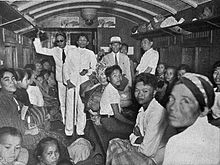Transmigrasi
Transmigrasi is a relocation and resettlement project started in 1969 by the Suharto government in Indonesia . 1.7 million families or 6.85 million people have changed their place of residence as a result.
Over half of Indonesia's population lives on the island of Java, which is extremely fertile due to volcanism . A correspondingly high population density and a scarcity of resources are the consequences. While Java is economically advanced, many of the Outer Islands are underdeveloped.
Through targeted relocation of families in the course of the so-called Transmigrasi project on the outer islands, the population pressure on the main islands such as Java was to be reduced and at the same time the economy of the outer islands was promoted. Only families who met certain conditions such as agricultural experience and the ability to read and write were accepted into the Transmigrasi project. The Transmigrasi families were supported in the period after the resettlement by initially providing housing and agricultural land as well as seeds and basic foodstuffs.
The project was financially supported both by the World Bank with 600 million US dollars and by German companies.
Problem
Armed conflicts arose on various islands between the Muslim Javanese and the ethnic groups , some of them Christian, who originally lived there , for example in the Moluccas and western New Guinea . On the island of Borneo in particular , there was unrest that led to the flight of immigrants from the indigenous people. At least 200 people are estimated to have died in massacres; other reports reported more than 2,000 deaths. The local police were barely able to protect the immigrants.
Because the land was divided up among the descendants of the immigrants, the area allocated to the resettlers was soon no longer sufficient. Reinforced by further immigrants who were looking for agriculturally usable land outside the project, large areas of the Indonesian rainforest were destroyed by slash and burn and deforestation.
The immigrants were also not prepared for the agricultural conditions. In contrast to the fertile volcanic soils on the island of Java, the newly reclaimed areas contained less nutrient-rich tropical soils . Inappropriate agricultural practices resulted in lower yields and thus impoverishment of the Transmigrasi resettlers. Many people returned home heavily in debt or driven by the conflicts.
literature
- Moving millions in a race against time . In: Geo Magazin 6/86.
- Ulrich Scholz: Transmigrasi - a disaster? Problems and opportunities of the Indonesian resettlement program In: Geographische Rundschau 44 (1992), issue 1.
Web links
Individual evidence
- ↑ INDONESIA: Avoiding collapse . In: Spiegel Online . tape February 9 , 1987 ( spiegel.de [accessed June 12, 2019]).
- ↑ Unrest: New massacre uncovered in Borneo . ISSN 0174-4909 ( faz.net [accessed June 12, 2019]).
- ↑ Doris K. Gamino: approaching an unknown land - Essay | APuZ. Retrieved June 12, 2019 .
- ^ The Jakarta Post - Review 2006: National. May 1, 2007, accessed June 12, 2019 .
